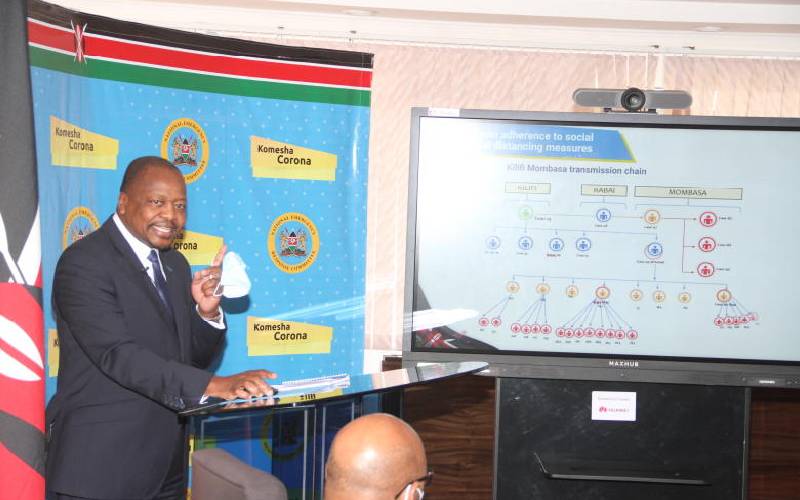
Health Cabinet Secretary Mutahi Kagwe explains the Covid-19 graph at Afya House in Nairobi. [File, Standard]
The World Health Organisation noted that the disease is behaving abnormally epidemiologically compared to how a pandemic normally would.
WHO said there is no enough data to ascertain the claim of a flattening curve even as President Uhuru Kenyatta held onto this narrative as he delivered his remarks yesterday during a virtual conference on the pandemic.
This scepticism seems to put to question the modelling used to determine the curve the disease will take in the country, which indicated that the pandemic will be at its peak around late August and early September.
Instead, the country has been reporting fewer cases a time when it should be experiencing a surge, which raises the question if the forecast was accurate or the Government has simply relaxed its testing.
SEE ALSO: Firm finds silver lining in telemedicine
According to WHO Kenya representative Dr Rudi Eggers, the latter holds more weight.
“The problem is we have been testing few cases and also contact tracing has been declining,” he said. “We might be (flattening the curve) but we cannot be certain that the cases are declining. We do not have sufficient data to verify this.”
Yesterday the Ministry of Health reported 144 new positive tests from 4,260 samples, raising the total number of confirmed cases to 34,201.
The number of deaths stands at 577 after three more patients died from the disease while recoveries stand at 19,893.
The less cases – according to Ministry of Health officials – are an early sign that the curve could be flattening, which the president has also alluded to.
SEE ALSO: Fund managers see growth as virus revives Kenyans’ savings culture
“I believe we have done remarkably well, and that is why we have begun to flatten the curve …but we must rather celebrate with a great deal of caution,” he said.
He said the curve is getting to the inflection point. “(This) is the most dangerous point as the curve can either flatten completely and deescalate or take an upward surge,” he said.
Ministry of Health officials have indicated that though the numbers are reducing, until a positivity rate of five per cent is attained and sustained for two weeks as per WHO standards, then it cannot be authoritatively said the curve has flattened.
According to yesterday’s figures of 144 cases against 4,260 cases; the positivity rate is 3.3 per cent.
Eggers, who also spoke during the virtual conference, said only data can clearly tell if the curve is indeed flattening. “We need to verify data, by gathering more substantial data to triangulate it with,” he said.
SEE ALSO: Investing during a pandemic
He said the relevant government agencies should collect data on hospital admissions, and deaths to clearly get the full picture. The right way to do this, he said, is to get data on all-cause mortality and compare it with previous year (2019). If there are excess deaths, then it gives a clear view of how the pandemic has fared in terms of mortality.
Credit: Source link